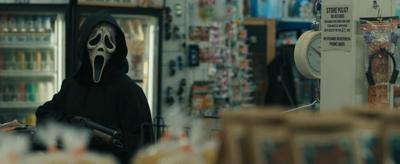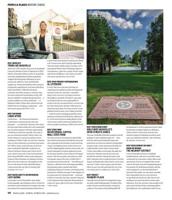With the ongoing tradition of well-executed murderscapes that open the Scream films, you can’t help but wonder how they’re going to take the elements audiences know and love and recombine them into something new. But this one hits the ground running with a sprint through the most terrifying terrain of all: dating in NYC. Yes, there’s a lot more metatextual fun and games (again feeling a tad obligatory — less is more in this instance), and some interesting choices that aim to dialogue with aspects of the franchise past. But all of that is secondary to the prime question: Is it scary? And yeah, Scream VI is definitely that.
In addition to moving to (Montreal guest starring as) New York City for its latest installment, the Scream franchise has finally found the hook for its new phase. 2022’s Scream was adrift in obligation and a rather wobbly sense of purpose, so it’s an utter relief that this sequel has figured out its motivation, leaning in to the grind of metabolizing trauma and battling humanity’s worst tendencies. If that sounds generic, it kind of is, but it’s also a noticeable step up from the last installment, so far the weakest entry in the franchise.
The Carpenter sisters, Samantha (Melissa Barrero) and Tara (Jenna Ortega), have left Woodsboro, Calif., for New York. Tara’s in college, along with Randy’s niblings Mindy and Chad. And Sam is around, staying militant and keeping eyes on the potential threats always looming right around the corner. But wouldn’t you know it, someone’s taking up the mantle of Ghostface once again. Because someone always has to. Freed from the tyranny of having a single icon as its central killer, the Scream films have a built-in ability to adjust to changing times and mores with the way that nine previous killers have donned the now-archetypal mask. There’s a sense here of something brewing in the air, of Ghostface threatening to spill beyond the boundaries of the survivors of the previous sets of Woodsboro murders. (Also, Hayden Panettiere is back as fan favorite Kirby, and it feels good and right.)
A Scream sequel lives or dies by its set pieces, and this one has three great ones — each of them using the locational reinvention in interesting ways. As someone who paid some dues for four years in NYC, I can say there are some little touches that can’t help but resonate: There’s an already legendary bodega battle, a chase involving a ladder, and a subway stalking that manages to be terrifying in a visually intriguing manner. It was the subway sequence that lit the fuse on seeing the 4DX version of the film before tackling this review, and it doesn’t disappoint.
The 3D conversion is well-done, and its 4DX motion track is superb, masterfully using stillness before slipping into an easy glide that feels just like hitching a ride on the camera dolly, or getting to live on one of Spike Lee’s traveling shots as a member of the audience, with jump-scares literalized in a mercenary fashion. But it amps up the fun factor exponentially, and there’s something reassuring and inspiring in the way that visceral horror can unite an audience. I may be tripping out on the gorgeous way that inconsistent interior lighting plays with the 3D on the 1 train, but everyone gets jolted by the staggering assortment of surprisingly gory, puncturing stabs that directors Tyler Gillett and Matt Bettinelli-Olpin (of Radio Silence) come up with.
You know what? I’m kind of glad they’re leaning into the ghost Skeet Ulrich angle, because it feels like the involved parties made a point to learn from the way the Friday the 13th series dropped the ball with the Tommy Jarvis arc. It’s a weird choice, and it feels nothing like any aspect of the original quartet (which is nice, honestly). Similarly, Ortega and Barrero are really good together, and their emotional back-and-forth feels much more lived-in and resonant than in the last film. As with all films set in New York, these characters’ apartments are way bigger than what they could afford (excepting legacy star Courteney Cox, who has a corner apartment with a wraparound balcony that tells us exactly how well being occasionally ethically squirrelly can pay), but Scream VI understands narrow NYC hallways.
There’s a point where this film certainly makes a choice, and what lingers about it (after two viewings) is how much it echoes a similar choice in a previous entry — one that seemed ridiculous at the time but is now considered classic by some. I’m tiptoeing around things because I don’t want to be a spoiler-critic unless it’s absolutely necessary. But it’s the only time I felt that things were skidding out of control. Granted, as with any film of this sort, there look to be some post-production-adjusted stakes. It doesn’t quite feel like some of the Weinstein foolishness that plagued 2 through 4, but it feels like Paramount wants to protect the non-Tom Cruise side of their portfolio.
At times it feels like writers Guy Busick and James Vanderbilt are trying to set up a comparative dialogue with Scream 2 (the previous "gone to college" entry), and sometimes it works beautifully. Instead of the glorious Agamemnon scene from that installment, we instead have the bones of a movie theater turned into a museum, isolated, dusty and alone but for the schemes of humanity and the focus of the audience. Neve Campbell (missed in VI, but acknowledged) as Cassandra is a thematic lightning strike, a reinvigoration of texts millennia old, drawing kinetic dread from the legacy of humanity itself. But the shrine to Ghostface we encounter is its mirror, a space cut off from the external, attempting to hold all of this generational tragedy in isolation, away from the rest of the world. Perhaps Part 7 will let us know which philosophy wins.





